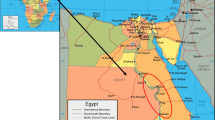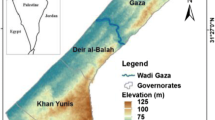Abstract
The nations that comprise the Gulf Cooperation Council (GCC) are located in one of the most water-stressed regions in the world. This region has faced serious socioeconomic and environmental development issues as a result of its increasing water demand over time. The extreme aridity, high rates of evaporation, and scarcity of nonrenewable groundwater resources in the GCC countries pose a significant threat to food security. This study aims to explore the impact of climate change on the potential availability of irrigation water in the State of Kuwait, which serves as an example of all GCC nations. A modeling scheme using CropWat8 was developed to study the impact of four climate change scenarios (encompassing the past, present, and future) on the net and gross irrigation water requirements (NIWR and GIWR) for selected agricultural crops, while also determining optimum irrigation schedules. Scenario 1 represented past climate conditions (1996–2006), while Scenario 2 represented the current situation (2007–2021). Projected scenarios (3 and 4) were analyzed using Representative Concentration Pathways (RCP) 4.5 and RCP 8.5, which were adopted by the IPCC to project the concentrations of greenhouse gases (GHG) emissions for 2060. The simulation results showed that compared with the current GHG levels, the increase in GHG emissions also increased the demand for NIWR by a minimum of 8.2% and a maximum of 15% for the same agricultural areas and cropping patterns. The measured GIWR in the field was 1915 m3, while the simulated NIWR was 1724 m3. With a drip irrigation efficiency of 90%, the model adequately demonstrated the validity of the CropWat8 package for simulating the climate impact on crop water requirements with a precision of approximately 92.2%. These findings suggest that the GCC countries should develop strategies to minimize GHG emissions and adopt innovative solutions for better management of water resources.






Similar content being viewed by others
Data Availability
Some data are available from the corresponding author upon requests.
References
Ahmed M, Al-Jabri SA, Choudri BS (2016) Green challenges and some technological solutions in the water sector of the Gulf Cooperation Council countries. In: M. Abdel Raouf and M. Luomi (ed.) The green economy in the Gulf. Routledge, 2 Park Square, Milton Park, Oxon OX14 4RN, London, UK
Al Jabri SA, Zekri S, Zarzo D, Ahmed M (2019) Comparative analysis of economic and institutional aspects of desalination for agriculture in the Sultanate of Oman and Spain. Desalination Water Treat 156:1–6. https://doi.org/10.5004/dwt.2019.24066
Allen RG, Pereira LS, Raes D, Smith M (1998a) Crop evapotranspiration: Guidelines for computing crop water requirements. FAO Irrigation and Drainage Paper No. 56, Rome. Food and Agricultural Organization. Roma 300(9)
Allen RG, Pereira LS, Raes D, Smith M (1998b) Crop evapotranspiration – Guidelines for computing crop water requirements. FAO Irrigation and drainage paper 56. Food and Agriculture Organization of the United Nations. In Irrigation and Drainage FAO
Almazroui M, Saeed S (2020) Contribution of extreme daily precipitation to total rainfall over the Arabian Peninsula. Atmos Res 231:104672. https://doi.org/10.1016/j.atmosres.2019.104672
Al-Menaie HS (2014) Prospects of Agriculture in the State of Kuwait-Constraints and Opportunities. In Environmental Cost and Face of Agriculture in the Gulf Cooperation Council Countries (pp. 43–59). Springer International Publishing. https://doi.org/10.1007/978-3-319-05768-2_3
AL-Omran A, Eid S, Alshammari F (2019) Crop water requirements of date palm based on actual applied water and Penman-Monteith calculations in Saudi Arabia. Appl Water Sci 9(4):69. https://doi.org/10.1007/s13201-019-0936-6
Asem SO, Misak RF, Alenezi A, Roy WY, Shahid SA, Al-Awadi M (2016) Effects of crude oil on some soil types of Kuwait. Kuwait J Sci Eng 43(4)
Doorenbos (1975) Guidelines for predicting crop water requirements. Ci.Nii.Ac.Jp. https://ci.nii.ac.jp/naid/10012763449/
Elnashar A, Abbas M, Sobhy H, Shahba M (2021) Crop water requirements and suitability assessment in arid environments: a new approach. agronomy 11(2):260. https://doi.org/10.3390/AGRONOMY11020260
Food and Agriculture Organization of the United Nations (FAO) (2022) Land & Water Division, Databases and software (CropWat). https://www.fao.org/land-water/databases-andsoftware/cropwat/en/
Gabr MES (2022) Management of irrigation requirements using FAO-CROPWAT 8.0 model: A case study of Egypt. Model Earth Syst Environ 8:3127–3142. https://doi.org/10.1007/s40808-021-01268-4
Gu Z, Qi Z, Burghate R, Yuan S, Jiao X, Xu J (2020) Irrigation scheduling approaches and applications: a review. J Irrig Drain Eng 146(6). https://doi.org/10.1061/(ASCE)IR.1943-4774.0001464
Gulf Cooperation Council (GCC) Statistical Bulletin (2016) Statistical Centre for the Cooperation Council for the Arab Countries of the Gulf (“GCC-Stat”). Muscat, Sultanate of Oman. https://www.gccstat.org/en/statistic/statistics
IPCC (Intergovernmental Panel on Climate Change) (2014) Climate change: synthesis report. In: Core Writing Team, Pachauri RK, Meyer LA (eds) Contribution of working groups I, II and III, to the fifth assessment report of the Intergovernmental Panel on Climate Change. IPCC, Geneva
Kumari N, Srivastava A, Chandra Dumka U, Holm JA, Lutz DA, Nham L (2021) A long-term spatiotemporal analysis of vegetation greenness over the himalayan region using google earth engine. Mdpi Com 9:109. https://doi.org/10.3390/cli9070109
Kuwait Environmental Protection Authority (KEPA) (2014) Environment protection law number (42) for year 2014 With it’s modification by law number (99) for year 2015. https://epa.gov.kw/Portals/0/PDF/EPALAWEN.pdf
Libardi LGP, de Faria RT, Dalri AB, de Souza Rolim G, Palaretti LF, Coelho AP, Martins IP (2019) Evapotranspiration and crop coefficient (Kc) of pre-sprouted sugarcane plantlets for greenhouse irrigation management. Agric Water Manag 212:306–316. https://doi.org/10.1016/J.AGWAT.2018.09.003
Omar SAS, Shahid SA (2013) Reconnaissance soil survey for the State of Kuwait. In Developments in Soil Classification, Land Use Planning and Policy Implications (pp. 85–107). Springer Netherlands. https://doi.org/10.1007/978-94-007-5332-7_3
Oxford Economics (2015) Will GCC countries be economies of the future or old oil ghost countries? http://www.oxfordeconomics.com/
Pereira LS, Allen RG, Smith M, Raes D (2015) Crop evapotranspiration estimation with FAO56: Past and future. Agric Water Manag 147:4–20. https://doi.org/10.1016/J.AGWAT.2014.07.031
PwC (2014) Price Waterhouse coppers (PwC). Achieving a Sustainable Water Sector in the GCC: Managing Supply and Demand, Building Institutions, by Tarek El Sayed and Johnny Ayoub
Raouf MA (2008) Climate change threats, opportunities, and the GCC countries. Policy brief No. 12. The Middle East Institute
Ravikumar V (2023) Sprinkler and drip irrigation theory and practice. Springer Nature Singapore Pte Ltd. https://link.springer.com/book/10.1007/978-981-19-2775-1
Schiattone MI, Viggiani R, di Venere D, Sergio L, Cantore V, Todorovic M, Perniola M, Candido V (2018) Impact of irrigation regime and nitrogen rate on yield, quality and water use efficiency of wild rocket under greenhouse conditions. Sci Hortic 229:182–192. https://doi.org/10.1016/J.SCIENTA.2017.10.036
Vishwakarma DK, Pandey K, Kaur A, Kushwaha NL, Kumar R, Ali R, Elbeltagi A, Kuriqi A (2022) Methods to estimate evapotranspiration in humid and subtropical climate conditions. Agric Water Manag 261:107378. https://doi.org/10.1016/J.AGWAT.2021.107378
WWF-GFN (2012) Living planet report 2012. Published by WWF in collaboration with Global Footprint Network and Zoological Society of London, 164 pp. Avenue du Mont Blanc, Gland Switzerland
Yang Y, Shang S, Jiang L (2012) Remote sensing temporal and spatial patterns of evapotranspiration and the responses to water management in a large irrigation district of North China. Agric for Meteorol 164:112–122. https://doi.org/10.1016/J.AGRFORMET.2012.05.011
Zamani Y, Hashemi Monfared S, Azhdari moghaddam M et al (2020) A comparison of CMIP6 and CMIP5 projections for precipitation to observational data: the case of Northeastern Iran. Theor Appl Climatol 142:1613–1623. https://doi.org/10.1007/s00704-020-03406-x
Funding
The authors would like to thank Kuwait Foundation for the Advancement of Sciences (KFAS) and Kuwait University for their funding of this work under project code: CN19-35EM-05.
Author information
Authors and Affiliations
Contributions
M. Alotaibi: data processing, performing calculations and estimations; N. Alhajeri: material preparation, data collection; conceptualization, methodology, writing-review, and editing; F. Al-Fadhli: data collection and analysis, investigation, visualization; S. Al Jabri: formal analysis, supervision, writing-review and editing; and M. Gabr: methodology, design, investigation, writing-review, and editing.
Corresponding author
Ethics declarations
Ethical Approval
Not applicable.
Consent to Participate
The authors declare that they are aware and consent with their participation on this paper.
Consent to Publish
The authors declare that they are consent with the publication of this paper.
Competing Interests
The authors declare no conflicts of interest.
Additional information
Publisher's Note
Springer Nature remains neutral with regard to jurisdictional claims in published maps and institutional affiliations.
Rights and permissions
Springer Nature or its licensor (e.g. a society or other partner) holds exclusive rights to this article under a publishing agreement with the author(s) or other rightsholder(s); author self-archiving of the accepted manuscript version of this article is solely governed by the terms of such publishing agreement and applicable law.
About this article
Cite this article
Alotaibi, M., Alhajeri, N.S., Al-Fadhli, F.M. et al. Impact of Climate Change on Crop Irrigation Requirements in Arid Regions. Water Resour Manage 37, 1965–1984 (2023). https://doi.org/10.1007/s11269-023-03465-5
Received:
Accepted:
Published:
Issue Date:
DOI: https://doi.org/10.1007/s11269-023-03465-5




